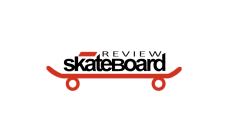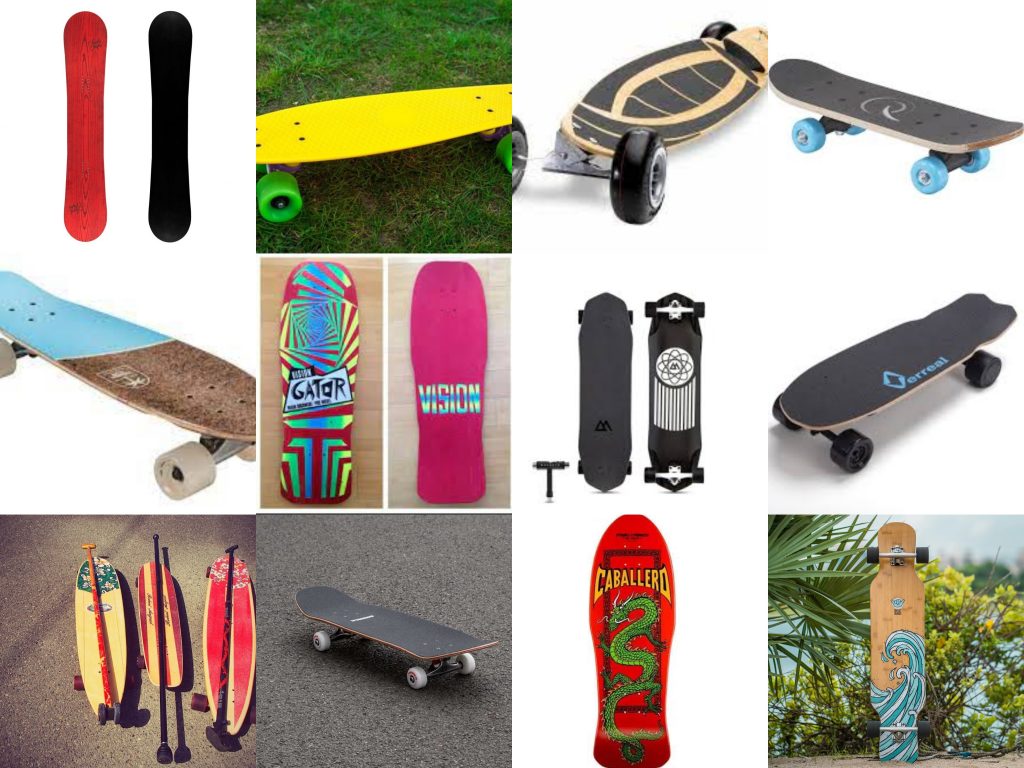
So we all know that skateboarding is a fun and exhilarating way to get around, and there are many different types of skateboards and longboards to choose from. Whether you’re a beginner or a seasoned pro, there’s a skateboard out there for you. Some of them have larger wheels, some have a prominent deck size, and many of them come with a variety of shapes.
This guide will change the image of a traditional skateboard in your mind, we’ll discuss the different types of skateboards and longboards, their features, and what skateboarding styles they are best suited for. All of these skateboards have notable pros and cons to consider. So you have to know about them too before heading to the skate parks with your favorite skateboard!
So whether you’re looking for kinds of skateboards to cruise around town, bomb hills, or do tricks, this blog post will serve as a guide.
1
Standard Skateboard
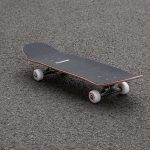
- Wooden Deck
- Metallic Truck with axles for steering and stability
- Reliable wheels and bearings
2
Mini Skateboard
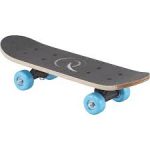
- Portable because of small deck
- Narrow trucks for quick turns
- Softer and larger wheels and bearings
3
Cruiser Skateboard
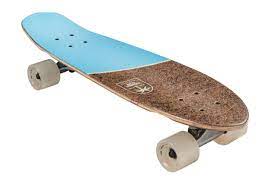
- Compact and Versatile Decks
- Trucks suited for stability and smooth turns
- Softer and larger wheels
4
Penny Skateboard
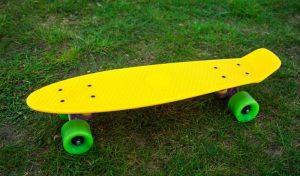
- Small and Lightweight decks
- Compact trucks for tight turns
- Soft and smooth wheels
5
Electric Skateboard
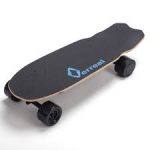
- Adjustable straps
- 9 vent holes and aerodynamic cut
- 3 easy-to-clean removable linings
6
Longboard
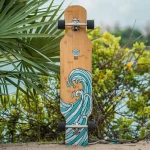
- Lengthy and spacious deck
- Wider and stable truck
- larger and softer wheels for higher speed and rough terrain
7
Freestyle Skateboard
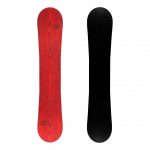
- Versatile deck suited for tricks
- Responsive and agile truck for quick turns and precise control
- Smaller and harder wheels for a good grip
8
Old-School Skateboard
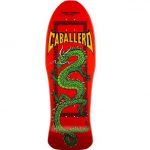
- Retro shaped deck with a wider nose and tail
- Wider and stable deck in a vintage design
- Large and softer wheels for a smooth ride
9
Pool Skateboard
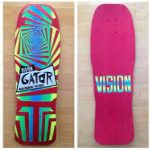
- Unique and durable deck shape
- Wider and stable trucks
- Smaller and harder wheels for an enhanced grip on pool surfaces with control
10
Downhill Skateboard
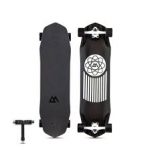
- Long and aerodynamic decks for stability at high speeds
- Wider and stable truck for precise control
- Large wheels with a hard durometer for maximum speed and grip on downhill slopes
11
Carve Skateboard
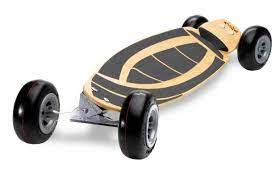
- Unique-shaped decks for smooth and flowing turns
- Responsive trucks to make fluid and tight turns with control
- Softer and larger wheels for grip and smoothness for carving and pumping
12
Paddle Skateboard
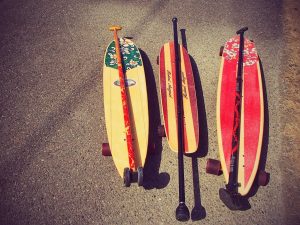
- Long shaft made of lightweight and durable material
- Paddle head is designed to push off the ground or pavement
- Adjustable shaft length - offering customizable options
The 12 Types of Skateboards and Longboards You Should Know About
1. Standard Skateboard
The standard skateboard is the classic skateboard that everyone knows and loves. It’s a versatile board that can be used for a variety of skateboarding styles, from street skating to park skating to freestyle skating.
Features
- Symmetrical shape with two kicktails for doing flip tricks and ollies
- Width of 7.5 to 8.5 inches for a comfortable fit
- Length of 28 to 32 inches for good balance and control
- Wheelbase of 13 to 15 inches for responsive turning
- Small and hard wheels for smooth rides and easy tricks
- Narrow and tight trucks for agile handling
Who is it for?
The standard skateboard is a good choice for beginners and experienced riders alike. So, you can call it a beginner skateboard. It’s a versatile board that can be used for a variety of skateboarding styles.
Here are some additional tips for choosing a standard skateboard:
- Consider your skill level. If you’re a beginner, you’ll want a board that’s easy to control. A wider board with softer wheels will be more stable.
- Think about the type of skating you want to do. If you’re interested in doing tricks, you’ll want a board with a good concave. This will give you more grip and control.
- Set a budget. Standard skateboards can range in price from around $50 to $200.
Pros
- Versatile and durable
- Compact and portable
- Affordable entry-level option
Cons
- Less stable at high speeds
- Limited for long-distance rides
- Smaller deck can be uncomfortable
2. Mini Skateboard
The mini skateboard is the pint-sized sibling of the standard skateboard. It’s a smaller, lighter, and more portable board that’s perfect for younger or smaller skaters who find a standard skateboard too big or heavy to handle.
Features
- Smaller size for easy handling
- Softer wheels for a smoother ride
- Shorter wheelbase for more responsive turning
- Suitable for casual cruising and learning basic tricks
Who is it for?
The mini skateboard is a good choice for:
- Younger or smaller skaters
- Beginners who are just starting out
- People who want a board that’s easy to carry around
- People who want a board for casual cruising
Here are some additional tips for choosing a mini skateboard:
- Consider the size of the skater. A mini skateboard should be no more than 7 inches wide and 28 inches long for most riders.
- Think about the type of skating you want to do. If you’re interested in doing tricks, you’ll want a board with a good concave. This will give you more grip and control.
- Set a budget. Mini skateboards can range in price from around $50 to $100.
Pros
- Highly portable
- Ideal for short commutes
- Agile and easy to maneuver
Cons
- Less suitable for tricks
- Limited foot space
- Less stable at high speeds
3. Cruiser Skateboard
The cruiser skateboard is the smooth operator of the skateboard world. It’s designed for cruising around town, carving up hills, and tackling any terrain that comes your way.
Features
- Wider and longer deck for stability and comfort
- Larger and softer wheels for a smoother ride
- Wider and looser trucks for more stability and flexibility
- Ideal for commuting, traveling, or carving on flat or slightly inclined roads
- Can handle rougher terrains such as cracks, pebbles, or grass
Who is it for?
The cruiser skateboard is a good choice for:
- Commuters who want a comfortable and stylish way to get around town
- People who want a board for cruising and carving
- People who want a board that can handle a variety of terrain
- Beginners and experienced riders alike
Here are some additional tips for choosing a cruiser skateboard:
- Consider the size of the skater. A cruiser skateboard should be no more than 10 inches wide and 36 inches long for most riders.
- Think about the type of skating you want to do. If you’re interested in doing tricks, you’ll want a board with a good concave. This will give you more grip and control.
- Set a budget. Cruiser skateboards can range in price from around $50 to $200.
Pros
- Diverse deck designs
- Great for cruising and commuting
- Smooth and comfortable rides
Cons
- Not isdeal for technical riding
- Limited maneuverability
- Less suitable for tricks
4. Penny Skateboard
The penny skateboard is a small, plastic skateboard that is perfect for cruising around town or just having fun. It is very lightweight and portable, making it easy to take with you wherever you go.
Features:
- Very small and narrow deck for easy handling
- Small and hard wheels for a smooth ride
- Narrow and tight trucks for responsive turning
- Lightweight and portable for easy transportation
- Perfect for urban commuting or just cruising around
Who is it for?
- Urban commuters who need a quick and convenient way to get around
- People who want a board for cruising and carving
- Beginners and experienced riders alike
Here are some additional tips for choosing a penny skateboard:
- Consider the size of the skater. A penny skateboard should be no more than 6 inches wide and 23 inches long for most riders.
- Think about the type of skating you want to do. If you’re interested in doing tricks, you’ll want a board with a good concave. This will give you more grip and control.
- Set a budget. Penny skateboards can range in price from around $50 to $100
Pros
- Good for short commutes
- Lightweight and easy to carry
- Ultra Portable
Cons
- Not suitable for tricks or technical riding
- Limited foot space
- Less stable at high speed
5. Electric Skateboard
The electric skateboard is a fun and convenient way to get around, without having to break a sweat. It is powered by an electric motor that can be controlled by a remote or an app on your phone.
Features:
- Similar shape and size as a cruiser skateboard
- Large and soft wheels for a smooth ride
- Wide and loose trucks for more stability and flexibility
- Can reach speeds of up to 25 miles per hour or more
- Can climb hills or go downhill with ease
- Ideal for gadget freaks who want to enjoy the thrill of skateboarding without breaking a sweat
Who is it for?
- Gadget freaks who want a convenient way to get around
- People who want to enjoy the thrill of skateboarding without breaking a sweat
- Commuters who want a stylish and eco-friendly way to get around
- People who want a board that can handle long distances
How to use it:
To use an electric skateboard, simply turn on the motor and start riding. You can control the speed and direction of the board using the remote or the app on your phone.
Safety tips:
- Always wear a helmet when riding an electric skateboard.
- Be aware of your surroundings and obey all traffic laws.
- Start slowly and gradually increase your speed as you get more comfortable.
- Avoid riding in wet or icy conditions.
Pros
- Low maintenance compared to gas-powered options
- Convenient and eco-friendly
- Fast and efficient transportation
Cons
- Reliance on battery life
- Limited range on a single charge
- Expensive initial cost
6. Longboard
A longboard is a type of skateboard that is longer than a standard skateboard, with a width of 9 to 12 inches, a length of 36 to over 60 inches, and a wheelbase of 18 to over 30 inches. The wheels are also larger and softer, ranging from 65 to over 100 mm in diameter and 75 to 85 A in durometer. The trucks are also wider and looser, which make the board more stable and flexible. A longboard is designed for high-speed, downhill, or distance riding on various terrains. It can also carve, slide, or pump like a surfboard or a snowboard. There are different types of longboards for different styles of riding, such as:
6.1 Pintail Longboard
The pintail longboard is a classic longboard that is perfect for cruising and carving. It has a pointed nose and tail, resembling a surfboard, and a smooth ride that makes it easy to control.
Features:
- Pointed nose and tail for a classic shape
- Smooth ride for cruising and carving
- Suitable for flat or slightly inclined roads
- Can handle rougher terrains such as cracks, pebbles, or grass
- Good for beginners and experienced riders alike
Who is it for?
- Cruisers who want a smooth and comfortable ride
- Carvers who want to make long, sweeping turns
- Beginners who want a board that is easy to learn on
- Experienced riders who want a versatile board that can handle a variety of terrain
Here are some additional tips for choosing a pintail longboard:
- Consider your skill level. If you are a beginner, you will want to choose a pintail longboard that is stable and easy to ride. A longer board will be more stable than a shorter board, and a wider board will also be more stable.
- Think about where you will be riding. If you will be riding on smooth surfaces, such as sidewalks or paved trails, you can choose a board with smaller wheels. If you will be riding on rough surfaces, such as gravel or dirt, you will need a board with larger wheels.
- Decide on your budget. Pintail longboards can range in price from around $100 to $500 or more. Choose a board that fits your budget and your needs.
- Read reviews. Once you have narrowed down your choices, read reviews of different pintail longboards. This will help you to decide which board is right for you.
6.2 Drop-Through Longboard
The drop-through longboard is a type of longboard that is designed for downhill, freeride, or distance riding. It has cutouts on the deck that allow the trucks to be mounted through the deck, rather than under it. This lowers the center of gravity and the riding height of the board, making it more stable and easier to push or brake.
Features:
- Cutouts on the deck for a lower center of gravity
- More stable and easier to push or brake
- Ideal for downhill, freeride, or distance riding
- Can handle higher speeds and sharper turns
Who is it for?
- Downhill riders who want a stable and maneuverable board
- Freeride riders who want to make long, flowing lines
- Distance riders who want a board that can handle long rides
- Beginners who want a board that is easy to learn on
Here are some additional tips for choosing a drop-through longboard:
- Consider your skill level. Drop-through longboards are a good choice for beginners and experienced skaters alike. However, if you are a beginner, you may want to choose a board with a lower center of gravity, which will make it more stable.
- Think about where you will be riding. Drop-through longboards are a good choice for cruising, carving, and downhill riding. They can also be used for freestyle tricks, but they are not as maneuverable as a traditional longboard.
- Decide on your budget. Drop-through longboards can range in price from around $100 to $500 or more. Choose a board that fits your budget and your needs.
- Read reviews. Once you have narrowed down your choices, read reviews of different drop-through longboards. This will help you to decide which board is right for you.
6.3 Drop-Down Longboard
The drop-down longboard is a type of longboard that is designed for stability and easy pushing. It has a concave deck that drops down at the center, creating a lower platform for the feet. This lowers the center of gravity and the riding height of the board, making it more stable and easier to push or brake.
Features:
- Concave deck that drops down at the center
- Lower center of gravity and riding height
- More stable and easier to push or brake
- Similar to a drop-through longboard, but with more foot space and more grip
Who is it for?
- Cruisers who want a stable and comfortable ride
- Beginners who want a board that is easy to learn on
- Freeride and downhill riders who want a board that is easy to control at high speeds
Here are some additional tips for choosing a drop-down longboard:
- Consider the length of the board. Longer boards will be more stable at high speeds, but they will also be less maneuverable. Shorter boards will be more maneuverable, but they will also be less stable at high speeds.
- Consider the wheelbase. The wheelbase is the distance between the trucks. A longer wheelbase will provide more stability, but it will also be less maneuverable. A shorter wheelbase will be more maneuverable, but it will also be less stable.
- Consider the drop. The drop is the distance between the deck and the ground. A lower drop will make the board easier to push and control, but it will also make it less stable. A higher drop will make the board more stable, but it will also make it harder to push and control.
- Consider the trucks. The trucks are the components that connect the wheels to the deck. Looser trucks will make the board more maneuverable, but they will also make it less stable. Tighter trucks will make the board more stable, but they will also make it less maneuverable.
- Consider the wheels. The wheels are the components that make contact with the ground. Larger wheels will provide a smoother ride over rough surfaces, but they will also be slower. Smaller wheels will be faster, but they will also provide a rougher ride over rough surfaces.
6.4 Double-Drop Longboard
The double-drop longboard is a type of longboard that is designed for ultimate stability and control. It has cutouts on the deck that allow the trucks to be mounted through the deck, as well as a concave deck that drops down at the center, creating a lower platform for the feet. This lowers the center of gravity and the riding height of the board even more, making it extremely stable and easy to push or brake.
Features:
- Cutouts on the deck for a lower center of gravity
- Concave deck that drops down at the center
- Extremely stable and easy to push or brake
- Perfect for downhill, freeride, or distance riding
Who is it for?
- Experienced riders who want a board that can handle high speeds and sharp turns
- Downhill and freeride riders who want a board that is easy to control
- Distance riders who want a board that can handle long rides
Here are some additional tips for choosing a double-drop longboard:
- Consider your skill level. Double-drop longboards are a good choice for beginners and experienced skaters alike. However, if you are a beginner, you may want to start with a longboard with a single drop.
- Think about where you will be skating. Double-drop longboards are best suited for cruising, carving, and downhill riding. They can also be used for freestyle tricks, but they are not as maneuverable as a traditional longboard.
- Decide on your budget. Double-drop longboards can range in price from around $100 to $500 or more. Choose a board that fits your budget and your needs.
- Read reviews. Once you have narrowed down your choices, read reviews of different double-drop longboards. This will help you to decide which board is right for you.
Pros of all longboards
- Spacious foot space
- Suitable for long-distance cruising
- Smooth and stable rides
Cons of all longboards
- Challenging for tight turns
- Reduced Maneuverability
- Less suitable for tricks
7. Freestyle Skateboard
A freestyle skateboard is designed for performing tricks and stunts on flat surfaces. The freestyle skateboarding intrigues everyone, and why it should not. After all it requires energy, fearlessness, and a stunt that only you have a solid grip on.
Features:
- Symmetrical shape with two kicktails
- Wider and flatter deck
- Larger and softer wheels
- Wide and looser trucks
Who is it for?
- Skaters who want to express their creativity and style on their board
- Skaters who want to learn tricks and stunts
Here are some additional tips for choosing a freestyle skateboard:
- Consider your skill level. Freestyle skateboards are a good choice for experienced skaters who want to do tricks and grinds. However, if you are a beginner, you may want to start with a longboard or a cruiser skateboard.
- Think about where you will be skating. Freestyle skateboards can be used in a variety of settings, including skateparks, streets, and pools. However, they are best suited for smooth surfaces.
- Decide on your budget. Freestyle skateboards can range in price from around $100 to $500 or more. Choose a board that fits your budget and your needs.
- Read reviews. Once you have narrowed down your choices, read reviews of different freestyle skateboards. This will help you to decide which board is right for you.
Pros
- Excellent for skating in park or streets
- Versatile skating styles
- Ideal for tricks
Cons
- Not suitable for long-distance rides
- Less stable at high speed
8. Old-School Skateboard
An old-school skateboard is a type of skateboard that is designed for pool skating or vert skating on ramps or bowls.
Features:
- Asymmetrical shape with a wider nose and a narrower tail for doing pool skating or vert skating tricks.
- Wider and longer deck than a standard skateboard for more stability and easier balance.
- Larger and softer wheels for a smoother ride and easier sliding.
- Wider and looser trucks for more flexibility and easier tricks.
Who is it for?
- Skaters who want to experience the nostalgia and history of skateboarding.
Here are some additional tips for choosing a old-school skateboard:
- Consider your skill level. Old-school skateboards are a good choice for beginners and experienced skaters alike. However, if you are a beginner, you may want to start with a longboard or a cruiser skateboard.
- Think about where you will be skating. Old-school skateboards are best suited for street skating, such as sidewalks, parks, and empty parking lots. If you will be skating on other surfaces, such as pools or bowls, you will need a board with different features.
- Decide on your budget. Old-school skateboards can range in price from around $100 to $500 or more. Choose a board that fits your budget and your needs.
- Read reviews. Once you have narrowed down your choices, read reviews of different old-school skateboards. This will help you to decide which board is right for you.
Pros
- Suitable for retro-style cycling
- Durable and robust construction
- Vintage, nostalgic design
Cons
- May not offer advanced features of contemporary boards
- Limited to old-school aesthetics
- Less Versatile for modern tricks
9. Pool Skateboard
A pool skateboard is a type of skateboard that is designed for pool skating or bowl skating on ramps or bowls.
Features:
- Asymmetrical shape with a wider nose and a narrower tail for doing carves, grinds, and airs.
- Similar shape and size as an old-school skateboard for more stability and easier balance.
- Large and hard wheels for better grip and slide.
- Wide and tight trucks for more responsiveness and agility.
Who is it for?
- Skaters who want to do tricks and stunts in pools or bowls.
- Skaters who want a more responsive and agile board.
Here are some additional tips for choosing a pool skateboard:
- Consider your skill level. Pool skateboards are a good choice for experienced skaters. However, if you are a beginner, you may want to start with a longboard or a cruiser skateboard.
- Think about where you will be skating. Pool skateboards are best suited for pools and bowls. If you will be skating on other surfaces, such as sidewalks or paved trails, you will need a board with larger wheels.
- Decide on your budget. Pool skateboards can range in price from around $100 to $500 or more. Choose a board that fits your budget and your needs.
- Read reviews. Once you have narrowed down your choices, read reviews of different pool skateboards. This will help you to decide which board is right for you.
Pros
- Excellent for transition and bowl riding
- Wide and stable deck
- Specialized for skatepark pool riding
Cons
- Not suitable for street tricks
- Not ideal for long-distance cruising
- Less versatile for other skateboarding styles
10. Downhill Skateboard
A downhill skateboard is a type of skateboard that is designed for downhill racing or freeriding on steep and fast roads.
Features:
- Symmetrical or asymmetrical shape with a wider and longer deck for more stability at high speeds.
- Larger and softer wheels for a smoother ride and easier braking.
- Wide and loose trucks for more flexibility and easier turns.
Who is it for?
- Skaters who want to take on challenging terrain and go fast.
Here are some additional tips for choosing a downhill skateboard:
- Consider your skill level. Downhill skateboards are a good choice for intermediate and experienced skaters.
- Decide on your budget. Downhill skateboards can range in price from around $100 to $500 or more. Choose a board that fits your budget and your needs.
- Hold your grip: Since it is for steep slopes, so the speed can be faster. Therefore, your grip has to be perfect to avoid any inconvenience.
- Read reviews. Once you have narrowed down your choices, read reviews of different carve skateboards. This will help you to decide which board is right for you.
Pros
- Precise control and stability at fast speed
- Long and stable deck
- Build for high-speed riding
Cons
- Not suitable for casual cruising or tricks
- Limited versatility
11. Carve Skateboard
A carve skateboard is a type of skateboard that is designed for carving on flat or slightly inclined roads.
Features:
- Symmetrical or asymmetrical shape with a wider and longer deck for more stability and easier balance.
- Larger and softer wheels for a smoother ride and easier pumping.
- Wide and loose trucks for more flexibility and easier carving.
Who is it for?
- Skaters who want to enjoy the smooth ride and fluid movement of carving.
- Skaters who want to commute or explore on a skateboard.
Here are some additional tips for choosing a carve skateboard:
- Consider your skill level. Carve skateboards are a good choice for intermediate and experienced skaters. However, if you are a beginner, you may want to start with a longboard or a cruiser skateboard.
- Think about where you will be carving. Carve skateboards are best suited for smooth surfaces, such as sidewalks or paved trails. If you will be carving on rough surfaces, such as gravel or dirt, you will need a board with larger wheels.
- Decide on your budget. Carve skateboards can range in price from around $100 to $500 or more. Choose a board that fits your budget and your needs.
- Read reviews. Once you have narrowed down your choices, read reviews of different carve skateboards. This will help you to decide which board is right for you.
Pros
- Surf-inspired design
- Ideal for carving and pumping
- Designed for smooth and flowing turns
Cons
- Not suitable for tricks
- Limited to carving and cruising
- Less versatility for other skateboarding styles
12. Paddle Skateboard
A paddle skateboard is a type of skateboard that is designed for dry land surfing or paddling on flat or slightly inclined roads.
Features:
- Symmetrical or asymmetrical shape with a wider and longer deck for more stability and easier balance.
- Larger and softer wheels for a smoother ride and easier paddling.
- Wide and loose trucks for more flexibility and easier paddling.
Who is it for?
- Skaters who want to experience the feeling of surfing on land.
- Commuters who want a fun and unique way to get around.
Here are some additional tips for choosing a paddle skateboard:
- Consider your weight. The weight of the paddle skateboard will affect how easy it is to push and maneuver. If you are a heavier rider, you will want to choose a board that is made of a durable material, such as bamboo or maple.
- Think about where you will be paddling. If you will be paddling on smooth surfaces, such as sidewalks or paved trails, you can choose a board with smaller wheels. If you will be paddling on rough surfaces, such as gravel or dirt, you will need a board with larger wheels.
- Decide on your budget. Paddle skateboards can range in price from around $100 to $500 or more. Choose a board that fits your budget and your needs.
- Read reviews. Once you have narrowed down your choices, read reviews of different paddle skateboards. This will help you to decide which board is right for you.
Pros
- Adjustable shaft for customization
- Long-distance cruising
- Unique full-body workout
Cons
- Requires learning and balance
- Less versatile
Conclusion
So, the park benches will be filled with spectators with your excellent skateboarding skills. The skateboard is not just a common type of skateboard. With the right skateboard type, you can show off your skills on smooth or textured surfaces.
After having studied the popular types, make an excellent choice for yourself. The types of boards you would pick will enhance the style of skating, but do not forget to control speed for a stable ride. We all know that one of the basic skill of skateboarding is an improved control!
